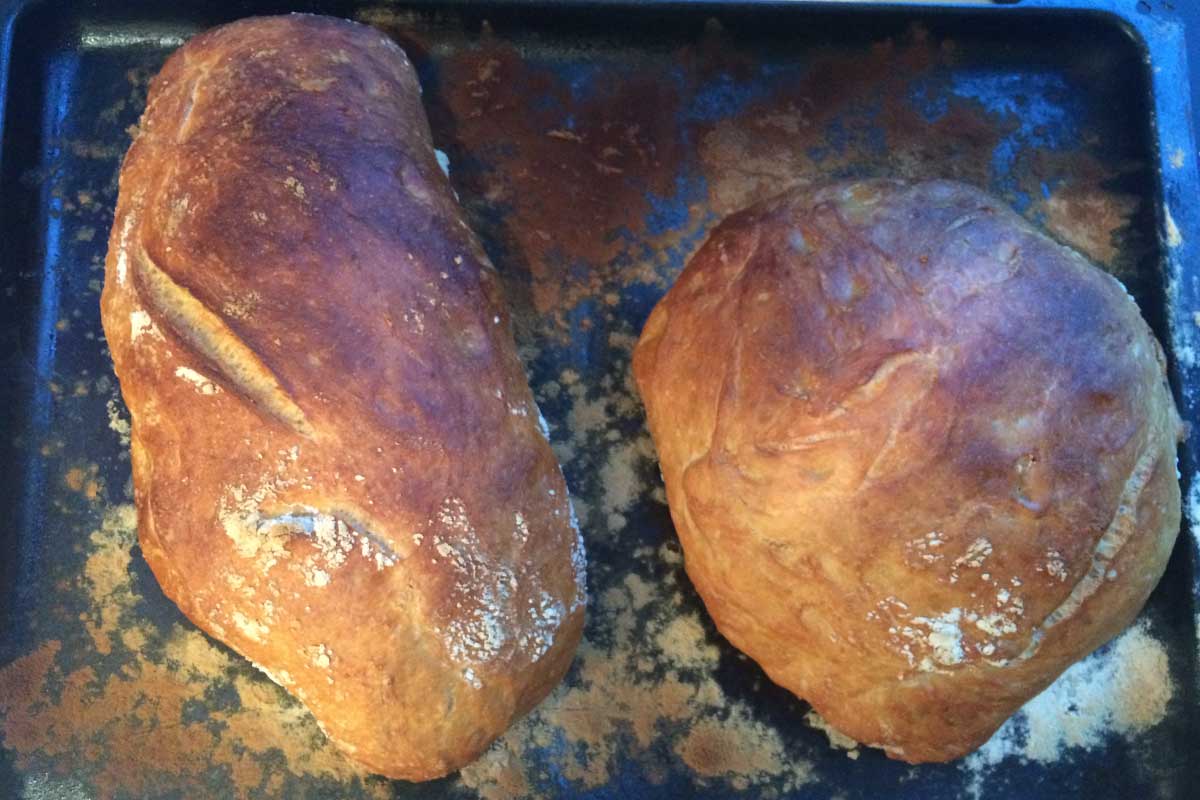With my roots in Europe, I love to make my own bread, dough and batter. I mostly make a full grain nut and seed bread, sometimes naturally leavened, but also Ciabatta or North European rye bread are favorites. In all these breads, significant pre-fermentation is key to the taste development. As when dough is fermented for some time, delicious flavors develop. And at the same time yeast cells are multiplied, which aid the final fermentation. So never be shy in letting doughs pre-ferment. You can greatly enhance the taste of a Ciabatta by a 24 h pre-fermentation of at the least half of the dough. The other main taste enhancer is the formation of the crust in the oven: the Maillard reaction -at higher temperatures- of sugars with amino acids, coming from the partially broken down starch and proteins in the dough provides a distinct taste to the bread.
The essence of kneading dough
Gluten form by the alignment of the guadin and glutamin molecules. Kneading is essential to develop the gluten that provide body to the breads and keep the dough light and ‘airy’. I always hand-knead the dough. This is an easy thing for ciabatta dough as it is wet and merely only requires ‘folding’ of the dough. But with the whole grain, nut and seed bread you can use your full energy on the dough! For the full rye breads, it is more mixing and shaping than kneading.
The type of flour is important to match its intended use. Higher protein containing flour is excellent for making breads that need rising power: multi grain and seed bread needs that, and ciabatta also. Canadian, very strong white flower, made of winter wheat, contains 14.9% protein and is an excellent source. However for making cake, and for making an efficient batter, low gluten content is desirable: between 6 and 9 % protein. If the recipe asks for high gluten flour and you have only all purpose flour of 9-12 %, you may add gluten to increase the protein content. Please note most of the gluten you buy or obtain from a baker is around 75-80% pure or in other words the gluten you buy has a protein content of around 75-80%.
Fresh and old bread
Finally, bread is at its best when it just comes out of the oven or pan and has cooled slightly down. Never store bread in the refrigerator. The starch in the bread retardates and the taste becomes stale quickly. Rather, slice the bread as soon as it has cooled down sufficiently and flash freeze it and keep it in the freezer. Take out pieces of bread to your need and place them in a bread toaster or in a ‘bread pan’ on a low fire, to re-vitalize them: you will be astonished by the taste!
Fermented and non-fermented bread
We find also fermented and non-fermented breads. Non-fermented flatbreads such as tortilla and chapati can be found in Mexico and Northern India, respectively. But pita bread (middle East) and naan (India) flat breads are fermented. China is using raising agents to make its wheat based mantou and baozi, which are steamed. Baozi also use yeast fermentation at the same time. The flour used for the steamed breads is lower in gluten as it will help to keep them soft.
Wheat noodles are eaten in parts of East Asia where the climate allows to grow wheat. In the streets of North China, you still see noodle places making their own noodle strands by hand stretching, which the gluten in wheat allow them to do. Where wheat does not grow, usually rice flour is the base for rice noodles or other rice based pasta. Vietnam is a great example. Rice noodles are gluten free and will not be able to stretch much.
Batter
Batter is used to protect foods from drying out when deep frying. It is preferred that gluten are not developed to prevent the crust becoming chewy. Therefore batters should use low gluten flour, some starch even, ice cold water or (butter)milk and should hardly be stirred. The Japanese barely mix their egg, flour and ice water containing tempura batter. They make it just before coating and deep frying and leave small lumps of flour undissolved. A lightly voluminous crust results after deep frying and which is not very oily.
Gluten adjustment in white bread flour
When making whole grain and seed breads or ciabatta bread, the rising power of the white bread flour is crucial. The protein content as often listed on the package provides a good indication of the rising power of the flour. This rising power increases in the order of the protein content in the flour: cake flour (6-8 %) -> all purpose flour (8-10 %) -> (strong) bread flour (11-13%) -> very strong bread flour (14.9%).
One can create a stronger flour from a lower rising power flour by adding gluten. Gluten are available in the specialized bakery section or from your baker. Usually gluten have a protein content between 70-78%. To make 1 kg of a very strong bread flour of 15% protein content from a strong bread flour of 13% protein content, add to 967 g strong bread flour (13%) 33 g of gluten (75%).
In some cases we do not like much gluten in the dough. Example are soft breads (such as cake) or batter to coat delicate, moisture containing foods before deep frying.
Gluten (protein) content is one thing, developing the gluten, which consists of two proteins, is another. Gluten develop when applying shear and stress to the dough at higher temperatures. No wonder tempura batter is hardly mixed with chop sticks and kept ice cold, whereas bread dough is kneaded at higher temperatures with high shear forces!



